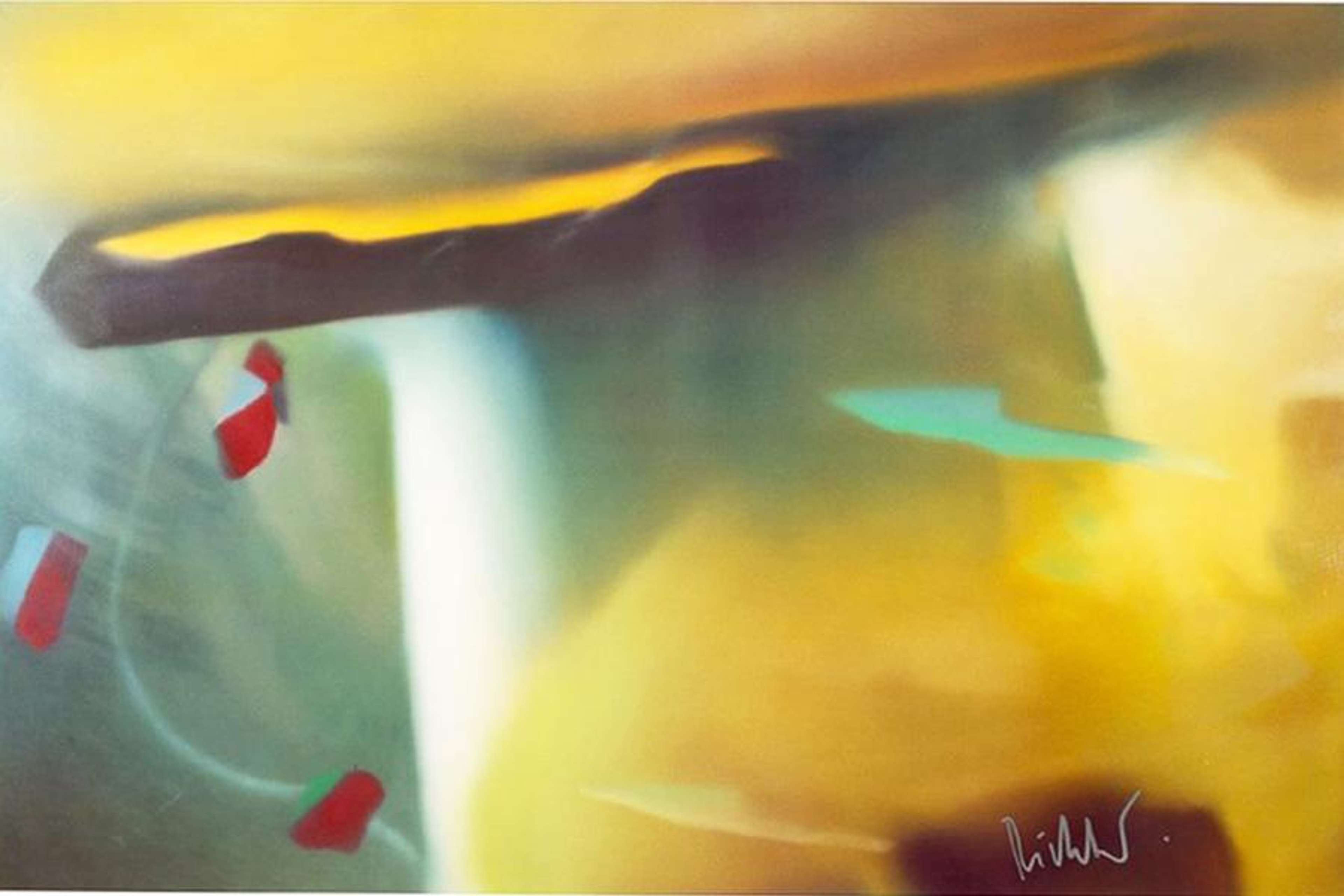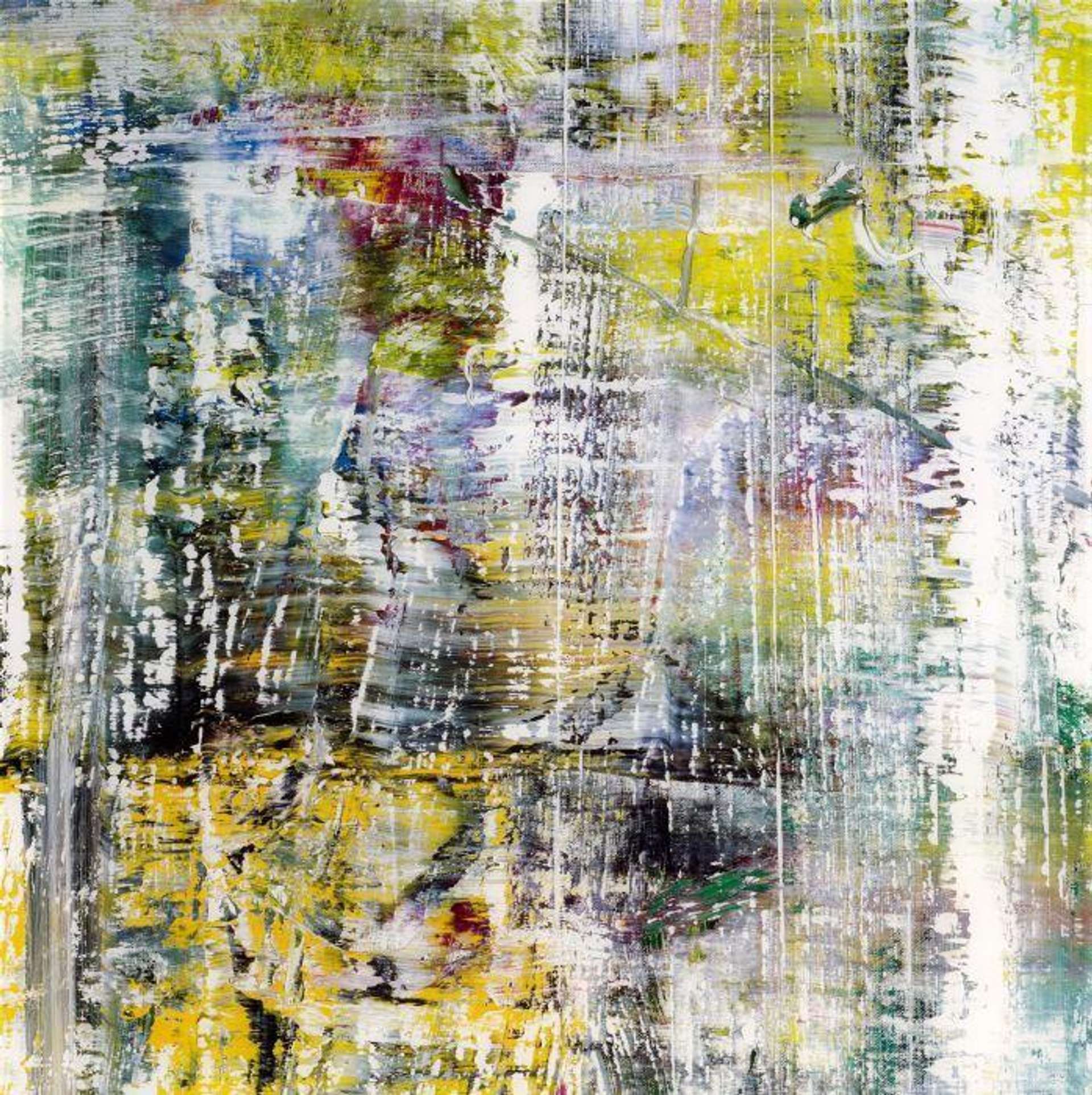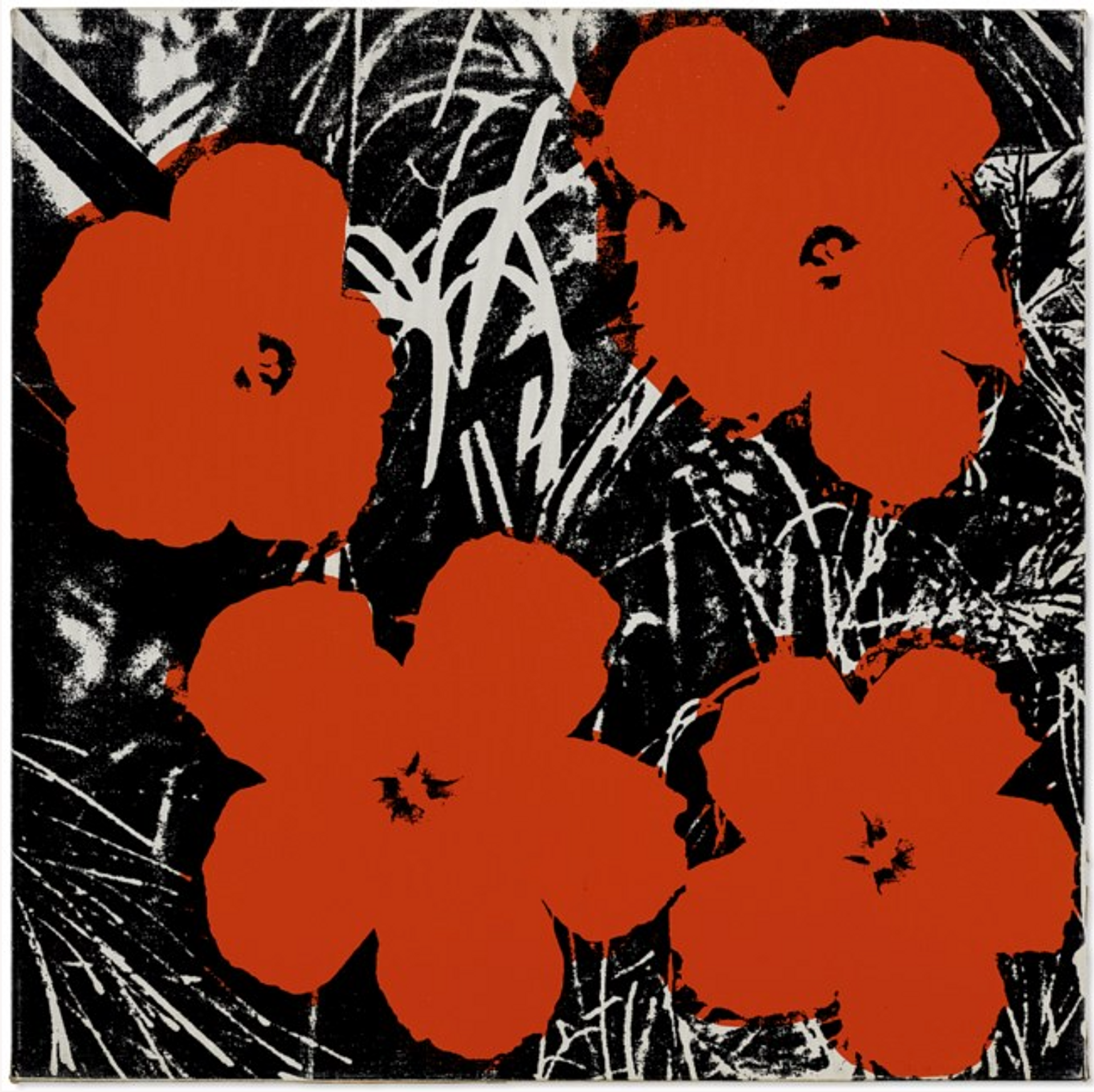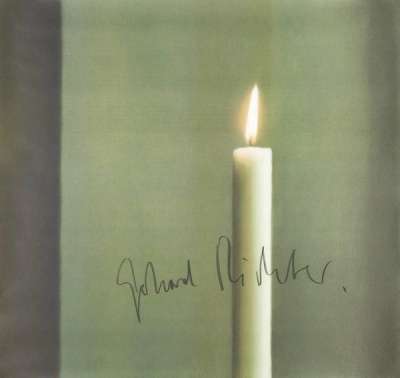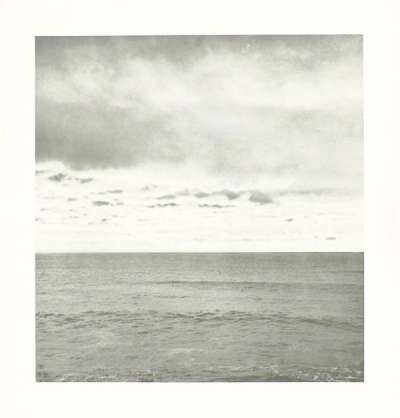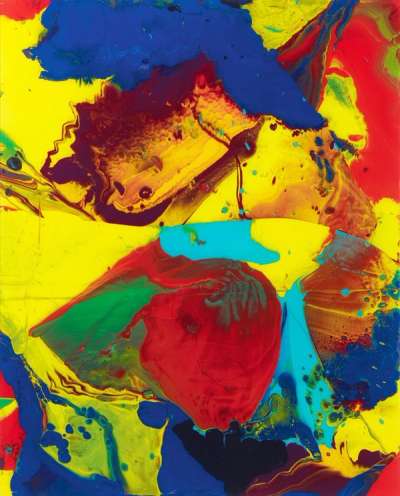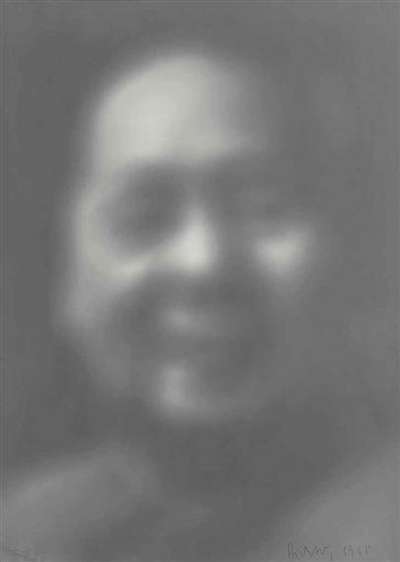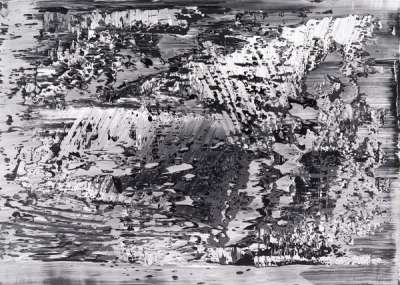 Flow (P4) © Gerhard Richter 2014
Flow (P4) © Gerhard Richter 2014
Gerhard Richter
141 works
One of the most famous artists to emerge from post-war Germany, Gerhard Richter, born on 9 February 1932, is a leading figure in Contemporary Art. His oeuvre spans from abstract to photorealistic paintings to photography and installation art. Celebrated as a pivotal Contemporary German artist, Richter's artworks have fetched record-breaking prices at auctions, underscoring his monumental impact on the art world.
A is for Abstraktes Bild
Abstraktes Bild, produced in 1990, stands out in Richter's career, highlighting a period of significant acclaim. It showcases his squeegee technique, emphasising the process of creation through subtraction, which results in canvases with dynamic streaks of colour. This series, from a crucial year, exemplifies Richter's impact on abstract art.
B is for Baader-Meinhof
October 18, 1977 is a series by Richter that delves into the complex narrative of the Baader-Meinhof group's tragic end in a Stuttgart prison in 1977. Richter uses this series to question the capacity of painting to represent reality, employing blurred images to capture moments from the group's history. Dominated by shades of grey, these works convey the emotional detachment of media images, offering a sombre reflection on the events and their portrayal. Produced 11 years after the events, the series remains a provocative examination of memory and media.
C is for Cage Paintings
The Cage Paintings by Richter, a series of six large abstract works created in 2006, exhibit a dynamic interplay of textures and layers. Influenced by John Cage, Richter's admiration for the composer's music is reflected in the paintings' complex surfaces, where layers of colour are both concealed and revealed through meticulous scraping and application. Each piece uniquely captures the essence of chance and deliberation, embodying Richter's sophisticated manipulation of paint.
D is for Daughter
In Betty (1991), Richter captures a tender moment of his daughter at eleven, draped in a red flowered bathrobe and gazing towards one of his paintings, highlighting the passage from childhood into adulthood. This depiction, based on a photograph, reflects a blend of presence and absence, engaging the viewer in a complex emotional dialogue. The work stands as a pivotal piece in Richter's exploration of painting and photography, blurring the distinctions between the two mediums to create an artwork which encapsulates the fleeting nature of the moment it captures.
E is for Engadin
Engadin is a book released alongside an exhibition showcasing Richter's connection with the Engadin region in the Swiss Alps, a landscape that has deeply influenced his work since his first visit in the late 1980s. Curated by Dieter Schwarz, the exhibition and the accompanying essay explore how the Alpine scenery has impacted Richter's artistic exploration. The show spanned three venues, including the Nietzsche-Haus and Hauser & Wirth St. Moritz, offering a comprehensive look at Richter's engagement with the natural world.
F is for Firenze
Richter's Firenze series, consisting of oil paint on photographs, draws inspiration from images captured along the Arno River in 1999. This special edition was crafted for the book Gerhard Richter: City Life, created to support Florence's Contempoartensemble, blending his photographic and painterly practices to celebrate the city's cultural landscape.
G is for Glass
Richter's work with glass, such as House of Cards (5 Panes), made in 2019, reflects his ongoing exploration of perception and reality. These works, including early pieces like 4 Panes of Glass from 1967, play with the ideas of reflectivity and transparency, engaging viewers in a dynamic interaction with the artwork and its environment.
H is for Haggadah (P2)
Haggadah (P2) is a 2014 limited print edition by Richter, the second part to his 2006 painting named after the Passover narrative text. The artwork invites viewers into a realm of uncertainty and intrigue, prompting a closer examination beyond its surface to uncover the depth within its complex, shifting layers. The artwork balances between the tangible, the abstract, and the representational, asking us to explore the meanings veiled within its diverse textures and forms.
I is for Isa Genzken
Richter and Isa Genzken, two significant figures in German art, were married between 1982 and 1993. Their collaboration on Tri-Star in 1981, a unique piece involving the sounds of an aeroplane motor captured on a phonograph record, showcases their shared commitment to conceptual art. Despite their individual artistic differences, Tri-Star represents a joint venture into creating enigmatic yet engaging artwork.
J is for Joseph Beuys
After moving to Düsseldorf in 1961, Richter had the opportunity to study under Joseph Beuys, one of the most influential figures in Post-War Art. This experience at the Kunstakademie Düsseldorf placed Richter in the midst of an innovative and challenging artistic environment, significantly shaping his approach to art.
K is for Kerze
Kerze (Candle), a series painted by Richter between 1982-83, showcases his fascination with light and shadow, capturing the ephemeral glow of a candle flame. This series, embodying a blend of photorealism and abstraction, marks a contemplative exploration of time and memory. Richter's technique, blending sharp focus with soft blur, invites viewers into a meditative space, bridging traditional symbolism with contemporary execution.
L is for Landscape
Landscape has been a significant genre throughout Richter's career, beginning notably with his 1968-69 Corsica series based on personal photographs. This focus extended to the German countryside, capturing landscapes to later transform into paintings, such as the notable Grünes Feld from 1969. Richter's landscapes explore beyond aesthetic beauty, probing the essence of what it means to depict German landscapes in the contemporary era, particularly considering historical contexts and the transition from photographic inspiration to painted expression.
M is for Mirrors
Mirrors, traditionally significant in Western art since the Renaissance and utilised by modernists for self-reflection, found new expression in the 1960s through American Minimalist sculpture, enhancing the viewer's self-awareness. Richter's engagement with mirror paintings, especially his reverse-pigmented mirrors, offers a modern critique of the avant-garde monochrome, merging painting with reflective surface to create a complex visual dialogue between the artwork and the viewer.
N is for Nazism
Richter's 2014 Birkenau painting series confronts the horrors of the Holocaust through abstract paintings based on clandestine photos from Auschwitz. Born in Dresden in 1932 and witnessing Germany's grave history, Richter has often engaged with themes of memory and collective trauma. Birkenau represents a direct engagement with this past, encapsulating his lifelong struggle with historical atrocities in his art.
O is for Onkel Rudi
Onkel Rudi (1965) by Richter is a grayscale oil painting resembling a black and white photograph, depicting Richter's uncle in a military uniform. This blurred portrayal, intimate yet uncanny, questions the reliability of photographic memory and historical representation. Through this portrait which resembles a family album photo, Richter explores themes of disappearance, memory, and the complex layers of personal and national loss.
P is for Panorama
Gerhard Richter: Panorama, a book written by Sir Nicholas Serota, offers the most extensive exploration of Richter's career, spanning his early years to more recent works up to 2015. This comprehensive text includes over 300 illustrations and insights from international critics. It stands as the definitive resource on Richter's impact on contemporary art.
Q is for Queen Elizabeth II
Richter's 1966 lithograph, Queen Elizabeth II, highlights his engagement with portraiture, juxtaposing figures of authority with Pop Art elements. This period marks Richter's exploration of photographic printmaking techniques to achieve a 'non-art' appearance, emphasising the mass dissemination of images. His work from this era, blending figuration and abstraction, reflects a political dimension and Conceptual Art influence, demonstrating his complex approach to representation and perception.
R is for Radical
Richter's career exemplifies radical experimentation, transcending conventional artistic movements to explore the vast spectrum of painting. His work, from photo-realistic portraits to abstract pieces, challenges traditional narratives of painting's role in art, particularly against the backdrop of postwar Europe and the conceptual shifts of the 1960s. Richter's diverse body of work, informed by his experiences in both East and West Germany, revitalises the medium, asserting paint's primacy beyond stylistic or thematic constraints.
S is for Sabine Moritz-Richter
Sabine Moritz-Richter, an artist in her own right, has been married to Richter since 1995, after starting as his student at the Kunstakademie Düsseldorf. Despite the challenges of navigating her role as a student, muse, wife, and mother within Richter's life, Moritz has remained dedicated to her artistic career. A 1997 portrait of Moritz by Richter, Koph (sketch), achieved significant recognition, selling for $2.33 million at a Christie's auction in 2010.
T is for Twin Towers
Richter's 2005 painting September reframes the photographic imagery of the 9/11 attacks through a process of obscuration, offering an intimate and blurred representation. This approach strips away the immediate clarity of mass media images, compelling viewers to engage more critically with the layers of memory and trauma associated with the event. Richter's method of altering his initially realistic depiction underscores a nuanced exploration of collective memory and the ways in which catastrophic events are mediated and remembered.
U is for Underground
The König-Heinrich-Platz U-Bahn station in Duisburg features an enamel mural by Richter, commissioned in 1980. This public art installation highlights Richter's profound impact, integrating his work into the daily lives of commuters.
V is for Vesuvius
Vesuv showcases Richter's unique ability to blend traditional landscape painting with modern abstraction. The series from 1976, focusing on Mount Vesuvius, marks a pivotal moment in Richter's exploration of the landscape genre, bridging his photo paintings and abstract works. This approach underscores his engagement with photography as a means to add depth and authenticity to his landscapes, creating a dialogue between the tangible and the intangible.
W is for Window
Richter's Cathedral Window for Cologne Cathedral, unveiled in 2007, features around 11,500 glass squares in 72 colours, showcasing a blend of random arrangements and deliberate choices to complement the window's architectural setting. This work, inspired by his 4096 Colours from 1974, is a testament to Richter's innovative approach to art. Corinna Belz made a documentary about the project, titled Das Kölner Domfenster, detailing the window's development, highlighting the extensive collaborative and creative process behind it.
X is for X Magazine
In 2013, X Magazine published a feature on Richter, showcasing a reversible poster of his work and discussing his groundbreaking techniques. The feature highlighted Richter's exploration of photo painting, colour chart painting, and abstract painting, demonstrating his unique ability to navigate between abstraction and embodiment.
Y is for Yellow-Green (Gelbgrün)
Richter's 1982 painting Gelbgrün stands as a monumental work in his transition towards abstract painting, marking the beginning of his significant Abstrakte Bilder series. Spanning over four metres, this piece is distinguished by its expansive use of yellow and green, creating a vivid abstract landscape that challenges traditional notions of painting. Exhibited in major retrospectives, including at the Tate Modern and Pompidou Centre, ‘Gelbgrün’ embodies Richter's exploration of the abstract as a means to capture the ineffable, blending painterly techniques with conceptual inquiry.
Z is for Zwirner
David Zwirner's 2024 London exhibit marks a significant presentation of Richter's work, exploring the dynamics of perception through new and recent works, including his abstract paintings, drawing and installation. Showcasing Richter's shift towards drawings, highlighting his experimental approach with graphite's blurring and abstraction, the exhibit is grounded in his characteristic formal investigation. This show reaffirms Richter's commitment to abstraction and the ongoing evolution of his artistic methodology.


